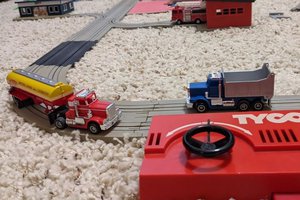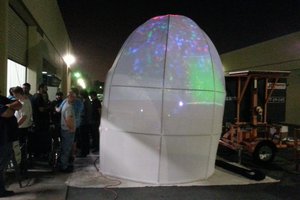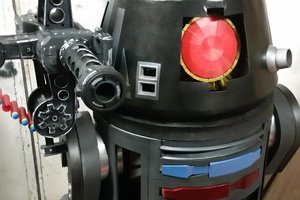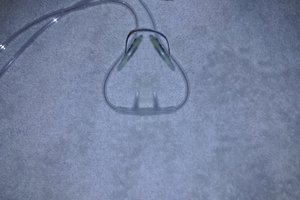This is very much an "about the journey" project.
Modified SMD tape magazines
A version of the SMD tape magazines that have built in DIN rails mounts
A version of the SMD tape magazines that have built in DIN rails mounts
To make the experience fit your profile, pick a username and tell us what interests you.
We found and based on your interests.
This is very much an "about the journey" project.
Hey, I made a part that (mostly) works!
And best of all, I used PLA as the mold. Mold release is definitely needed.
The PLA mold is much less expensive to set up than the silicone mold but it comes with some drawbacks. With a silicone mold it is possible to flex the mold in order to make your part pop out. Rigid molds can't be folded so they need a different mechanism to remove the part. Injection molding folks use ejector pins.
Presumably that's the thing you need if you're making a mold that reliably makes hundreds of thousand of parts but I'm interested in learning how to make a few hundred parts without spending too much money.
So, from the big box home store, I have a box of nails.
Now, in my head nails always looked like ejector pins. But upon close inspection I see significant diameter variance, weird surface finishes, bent nails, massively out of round heads, and weird rib structures that were produced as part of some forming process.
I have a big box of nails, so I can avoid some of the issues. Other ones (out of round heads) aren't as important. But those ribs between the head and the shaft are a problem. Fortunately, the nails can be popped into a drill chuck and worked over with a file.
The resulting part is much better than what I started with, but nothing remotely like a proper ejection pin, so I coat the bottom of the nail head with petroleum jelly.
I've cut the resulting nails so that they all stick about 10mm down from the bottom of the mold.
This is good for two reasons. First, putting longer pins into the mold is much easier. Secondly, once the resin has cured I can push the mold down onto a table and that makes the pins push up and eject the part.
Note: this wasn't the actual part ejection. I put the part back in the mold to demonstrate the pins working.
I've still got a number of problems to work through:
First of all I'm degassing the resin and that works but when I'm pouring the resin I'm re-introducing a ton of bubbles.
I don't think pressure casting will work with a semi-hollow PLA mold, so I'll either have to work on a better pouring technique or try something else. The documentation says this resin is good for cartridge dispensing, so I've ordered some equipment to give that a try. If that works it'll actually be ideal because it'll open the door to fast work time resins that can be removed from a mold in about an hour.
Second, I goofed and when I adjusted the front triangular piece so that it was more taller I forgot to adjust the lever point for the DIN clip and there's no longer clearance to use the lever point with a standard screwdriver.
Third, the resin is a bit slippery and it might be nice to have a lid to keep the SMD tape from tipping out.
And lastly, I'm exploring some additional mold release compounds. I have some parting wax and PVA that will get here sometime RealSoonNow.
The initial casting with the MD-50 elastomer produced a pretty nice looking product. It was really bendy when it came out of the mold, but after 16 hours at 70C it stiffened up considerably. The walls are definitely too thin and the DIN clamp needs to be beefed up.
It would be nice not to iterate blindly, so I hung a water bottle on a paper clip and filled it with a couple different weights of water. With 100g of weight I'm seeing about 8mm of displacement.
With some hackery I created a material in Fusion360 that produced similar results. Note: These are not real values! Don't expect them to do anything remotely correct.
So hooray for that. Time to tweak some parameters and build some bracing.
In other news: I'm having some luck casting directly into PLA without bothering with making a silicone mold. I need to do some more experiments.
Also, my fail of the week was trying a significantly more rigid resin in the mold. The walls are far too thin for this stuff and it didn't survive demolding.
In any case, it was a good reminder that things that are rigid are also usually brittle.
In order to get a part to more easily come out of a mold it's important to add a draft angle to the walls. Straight parts drag against the walls as they're ejecting from the mold.
Whereas parts with a draft angle separate immediately.
Silicone molds are very forgiving when it comes to draft angles. The material is stretchy and you can get away with both vertical surfaces and even some undercuts on your parts. From what I've been reading, other molds are not so forgiving and adding draft angles is required. Even with the silicone molds adding draft angles is going to help the part come out of the mold.
It turns out Fusion360 has a tool to add draft angles to your models.
So far so good. Where I previously ran into trouble was that adding a draft angle to the DIN rail clip made the magazine grip the rail badly. The draft tool is supposed to allow for deselecting certain faces but I found that interface to be too quirky to work with on my model and I added draft angles during the extrusion steps.
I'm about to revise my design based on what I learned from a test casting, so I thought I'd try out a few ideas on how to work around the issues I hit with the Draft tool.
I'm making changes to fix a few specific problems.
I wasn't very careful when pouring my test mold and I wound up with some problems with some tall narrow areas. For the main tape passage I'm just going to have to be careful not to trap an air bubble, but some of the other small openings don't have to be designed this way.
Also, I'm missing the flat front and larger top nubbin from the original design as that gave additional room for labeling.
So, getting started!
First thing I'm doing is adding a bunch of parameters. InteriorDiameter, TapeWidth, and TapeHeight reflect the tape dimensions and will be adjusted to produce multiple outputs.
Some of the other parameters (RailSqueeze, DINSlotWidth/Height) relate to fitting printed parts together and I prefer adjusting them in the parameters dialog. DINWidth is there as a constant so I can type DINWidth-RailSqueeze as a dimension.
LowDraft and HighDraft are values that are going to be used to set draft angles. 5 and 8 are absurdly high angles, but it makes it easy to see when I've flipped angles backwards. I'll change those to something more like 1.5 and 3 degrees for the final product.
I'm going to create the drawing for the DIN rail connector except that i'm going to leave out the actual critical surface for the rail connection. If I wait until the last step then I can have a lot more control over what (if any) draft angles are used.
The next bit is the big circle that holds the tape. The exterior of the circle is constrained to be tangent to the DIN rail. This leaves the circle unconstrained in one axis (up/down in the picture).
To constrain the second axis I construct a horizontal line that's offset from the other part of the DIN connector and make the circle tangent to that line. I've found this to be a very reliable method of constraining parametric geometry and Fusion360 won't randomly reverse dimensions or flip them around to odd angles.
Then it's a quick job to build some squares in the corners of the design and extrude once with the floor thickness + tape thickness.
From now on try to only use extrude with distance of To Object. Connect things together.
That seems to keep Fusion360 from getting confused when the parameters change. That becomes doubly important later if fillets are added and Fusion tries to figure out how to maintain the features.
Now check to make sure the model is stable over a reasonable span (in this case 50mm to 120mm).
Keep going but:
* Don't apply a fillet between the interior and exterior of the geometry
* Don't add the passage for the film
Now apply the draft tool. The hard corner between the interior and exterior makes fusion360 do the right thing
Make sure to...
Read more »My semi-rigid resin should be arriving soon! In the mean time I thought I'd have some fun and try casting some hot melt. As expected the result was a bendy version of the part. This isn't particularly useful for this project, but it might be a good approach for other sorts of parts.
I wonder if there's something that can be mixed into hot melt to make a more structurally sound composite material. I've done some searching for
On the bright(ish) side, I discovered that my test mold has a significant issue where an air bubble bridged an important part, so I'll be able to re-make the mold before I start using the resin.
So, what's this going to cost?
For the cast material I want something that's going to be semi-rigid so that it doesn't break when I clip it to a DIN rail. I'm thinking about using MD 50 from BJB. I haven't used it before, but the spec sheet sounds pretty good.
How much do I need?
Conveniently, Fusion360 knows how big solids are and has that info under the Properties menu option
My 80mm internal diameter magazine has a volume of 2e4 mm^3
I was brought up badly and so my brain needs that in different units:
2*10^4 mm^4 = 1.22 in^3 = 0.68 fluid oz (us)
The MD-50 spec sheet says the gallon kit gives 301 cubic inches of material. Fudging the volume up to 1.25: 300 / 1.25 = 240. Now, I have no plans to make 240 of these things, so per-part cost estimates here are going to be a mental exercise.
The gallon kit costs $114. Assume taxes and shipping push that to $130. $130/240 = $0.54. If I screw up a bunch $130/200 = $0.65
So far so good
According to Cura my 3d print of the same part consumes 21g of filament.
If I pay $30 for 2kg of filament: ($30/2000g) *21g = $0.315
I'm trying to tell myself comparing PLA to resin is like comparing plywood to oak.
Now for the mold.
Previously I've used a couple different silicone types from smooth-on. That works but it's a bit on the expensive side.
How much do I need?
I need at least one mold, but in order for this to make any sense I either need a bunch of molds or I need a mold that has a very low cycle time. MD-50 takes 4 hours before it comes out of the mold, so it'll have to be multiple molds.
Starting with one mold.
Adding 12mm of thickness outside my magazine I wind up with a mold that looks like this:
It has a volume of 3.546e6 mm^3 = 21.6 in^3 = 12oz
I can get a gallon of silicone for about $130 and I can get about 10 molds out of that kit, so $13/mold
Let's pretend I'm going to scale up and make all 240 magazines.
$130 + 130 = 260
260 / 240 = $1.08 per unit
If I could cycle the molds 3 times in a day that would allow for a production rate of 30 per day.
That's starting to sound promising, but there's a lot of room for improvement.
I printed some SMD cartridges and I'm generally really happy with the design, but I noticed a few things I thought could be a bit better.
The first is that the path that the film exits through is quite wide. Normally that's probably not a problem, but I'm a bit clumsy and prone to knocking things over, so I'd prefer a design where a part couldn't slip out through that gap.
So I put together a quick design in Fusion360 with a narrower film gap and tried putting my roll of WS2812B tape into the magazine and it didn't quite fit, so I'll want to print a bigger version.
How much bigger? It would be good to get a number before getting started[1]
Well, how much tape of a given thickness can be held by a given diameter of magazine?
The tape follows a path that resembles an Archimedean Spiral
In polar coordinates the spiral is described by
where a is a constant offset from the center and b controls how much the radius increases per radian traveled.
We're starting at the middle, so a is zero.
The radius increases one tape thickness for each full circle. Taking a given tape thickness t and substituting into the above equation gives:
The tape I'm using is between 2mm and 2.5mm thick. Substituting those values give b of 0.318 and 3.98
For a given radius and thickness theta can be found
Subbing in 30mm for the radius and our b values that gives thetas of 94.25 and 75.4. That's the end of where we need to integrate. The start should be some number greater than or equal to zero. A tape can't be wound down to a point, so I'll use 2pi as the lower bound of the range.
Taking those numbers and plugging them into into Wolfram Alpha gives
So, somewhere between 1.1 and 1.4 meters.
How close is that result to reality?
Only thing to do is to mark where the tape starts to go into the magazine
and measure
1.37 meters! That's in the expected range.
Using that to refine my model suggests that a 40mm radius magazine would hold 2.4m of tape and a 50mm radius would hold 3.8m of WS2812B tape.
[1] - It would've been a good idea, but I just doubled the diameter and started modeling a prototype in Fusion360. I'm going back and writing up notes because I got curious.
Create an account to leave a comment. Already have an account? Log In.
I look forward to learning from your design process. Thanks for posting it!
I really liked the original project too, but having to 3D-print all those cassettes seemed daunting. Casting them seems like a win for mass production, as long as you cast more than one at a time to make it faster than printing.
Sounds like a great idea. Looking forward to progress!
Thanks!
I'm working on the logistics of scaling up mold making to many per night. There's a lot of interesting stuff to learn!
I built a small pressure vessel for my daughter so she could resin-cast D&D dice for Christmas presents this year, and I was surprised how well it worked. Just a thrift-store pressure cooker and some air fittings, but it really improved the cast quality. I thought degassing in a vacuum would be better, but pressure was far easier and worked fine.
Good luck!
I will have to give that a try! Even with degassing it can be tricky to get all of the bubbles out.
Become a member to follow this project and never miss any updates

 Mike Turvey
Mike Turvey
 T. B. Trzepacz
T. B. Trzepacz
 Kenneth Zaborny
Kenneth Zaborny
 Carl Giles
Carl Giles
How to download project?